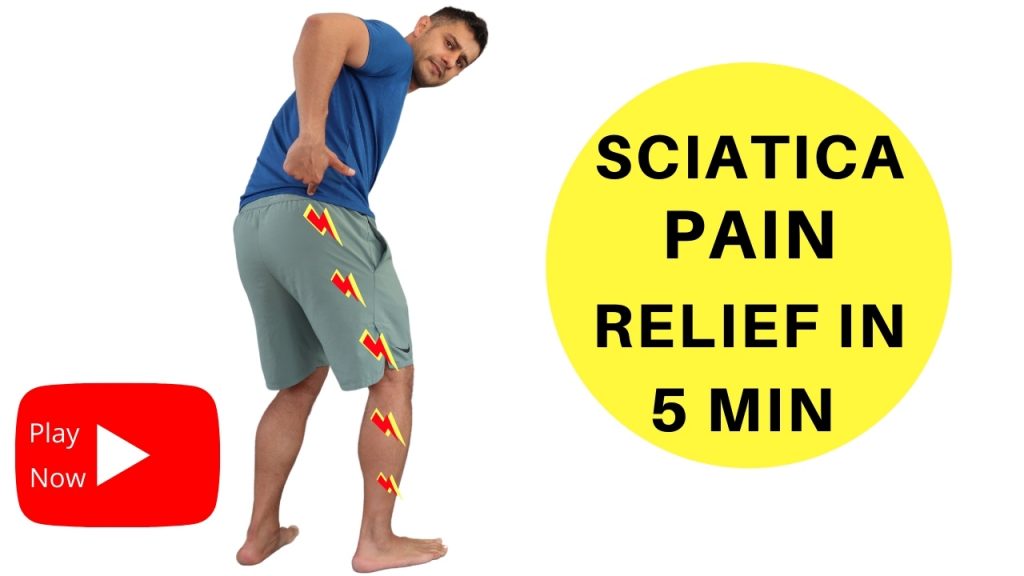How to treat sciatica?
Most cases of acute sciatica will pass without the need for treatment. You can follow this home self-help advice and usually help relieve the symptoms. However, for persistent sciatica, we suggest you may be advised to try a structured exercise program under the supervision of your Physical Therapist.
The cause of sciatica
The vast majority of cases of sciatica have a spinal cause, such as disc herniation or rupture causing impingement of L5 or S1 nerve roots. Other common causes of sciatica can include spinal stenosis, degenerative disc disease, and spondylolisthesis. There are also many non-spinal causes or sciatica, which are less common: These include piriformis syndrome, trauma, postoperative complications.
Diagnosis
Sciatica is mainly diagnosed by history taking and physical examination of the patient by a physical therapist.
Sciatica sign and symptoms
– Moderate to severe pain in the lower back, buttock, and down their leg.
– Numbness or weakness in their lower back, buttock, leg, or feet.
– Pain that worsens with movement; and may cause loss of movement control.
– Pins and needles” feeling in their legs, toes, or feet.
In this video, I share with you a series of exercises and tips for sciatica pain relief. Watch the video till the end and follow my tips for quicker recovery.
Exercises for sciatica pain relief and sciatica nerve-tingling sensation:
1- Sciatica nerve glide
This exercise can help you with the sciatica pain and nerve-tingling sensation. We presume you have the pain and tingling in your left leg. You’re going to lie down on your back and find a comfortable position. Bring up the left knee to your chest to the point that feels comfortable. Then you are going to extend the knee and bring your toe to dorsiflexion. Try to extend the knee to the point that feels comfortable and you start to feel the stretch. You may try this movement for 3 sets of 10 to 12 repetitions.
This exercise will help you to reduced sciatica pain and nerve-tingling sensation.
2- Figure 4 stretch
This exercise is beneficial for sciatica pain and will help you to relieve pain from the buttock and improve your hip mobility. We presume you have sciatica pain in your left leg. You’re going to lie down on your back and find a comfortable position. You are going to cross the left knee, and then bring the left knee to your chest, as far as you start to feel the stretch. Avoid letting your lower back come off the ground. And hold this stretch for 30 sec. You may try this stretch for 3 to 4 repetitions. If you don’t feel comfortable lying on your back, you can try the figure 4 stretch in the seated position and hold it for 30 sec for 3 to 4 repetitions.
If you suffering from sciatica, figure 4 stretch can help you to relieve pain from your buttock and improve your hip mobility.
3- L 4 L5 / L5 S1 Decompression exercise
If you suffering from Sciatica pain, The L4 L5 / L5 S1 decompression exercise is a passive stretch that can give you immediate sciatica pain relief. With the help of gravity, this exercise help to reduced the pressure between your spinal discs in your lower back. You will need 2 to 3 pillows for this passive stretch. Position the pillows between your hip bone and your belly button. And make sure to relax your arms and your feet, and find a comfortable position. Stay In this position for 45sec for 3 to 4 repetitions, and make sure to stay relax and focus on your breathing. The goal of this stretch is to let gravity creates a decompression between your spinal discs and improve your sciatica pain and discomfort.
4- Sciatica seated nerve glide
This exercise can help you with Sciatica pain and improve the nerve-tingling sensation. In this exercise, you will need a small stool to raise your leg slightly. Or you may use a couple of books. Bring your foot to the dorsiflexion, keep your knee locked, and sit upright. In this position, you may feel the stretch already and you are going to gently side bend to the opposite side. You may repeat this exercise for 3 sets of 8 repetitions. Remember to avoid any jerky movement. Seated sciatica nerve glide is a low-impact movement and it helps you to reduce sciatica pain and improve sciatica nerve sensitivity.
In Dublin Sports Injury Clinic we see a vast majority of patients with lower back pain, and we help those individuals with pain education and prescribed exercise and rehabilitation routine. If you experience back pain or you would like to prevent back pain you can contact us and we will assist you with a customized treatment and training routine that suits you and improve your lower back pain.
PS. We are not claiming with following this routine you will not going to experience back pain. Back pain is multifactorial and if you experience back pain, make sure to contact your physical therapist for optimum results.
Our Approach
Dublin Sports Injury Clinic is a physical therapy clinic based in Pearse Street, Dublin 2. We have a high volume of patients who are treated with low back pain. Initially, our treatment will be focusing on helping our patients to get pain free as quickly as possible. We educate our patients to understand the cause of their back pain and how they can stay pain-free. Rehabilitation exercises will be customized for every patient and we show them the correct techniques and progression.
FOLLOW US ON YOUTUBE AND GET ACCESS TO OUR WEEKLY FREE REHABILITATION EXERCISES.
Next step
Want to get in touch with our team of a therapist or you are looking for some advice? Simply fill in your details below & we get in touch with you shortly.
Disclaimer: This article is for information only and should not be used for the diagnosis or treatment of medical conditions. You can contact us if you would like to book an appointment or get some advice from our therapist.


